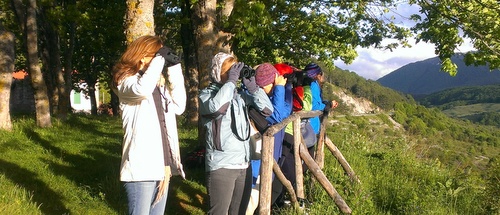The first tour of our Italian season took us to the wild landscape of Abruzzo, in the central Apennine region of Italy. Abruzzo is home to many National Parks but the Parco Nazionale d’Abruzzo, Lazio e Molise itself is home to some very special residents.
History
The Marsican brown bear has lived in this area for centuries. Sources suggest that the bears first made their way down the Apennine spine from the eastern Balkan area. All the Italic pre-Roman populations who lived in Abruzzo would have hunted bears and there are many texts through the centuries which attest to the bear population. The bear is now the symbol of the National Park, although wolves, chamois and deer also live here.
Population
Sadly the population today is limited to some 50 or 60 bears. The erosion of their natural habitat and deliberate attempts by man to remove them has left them vulnerable and endangered. They are naturally shy and timid creatures who are more active during the hours of dusk and darkness. They have no natural predator but modern roads and railways, poaching and toxic substances have all contributed to their dwindling numbers. The female is pregnant for six months and usually gives birth to one or two cubs, but they stay with her until they are fully mature at the age of 2, which means a female will only give birth every three or four years. This too contributes to the slow development of a larger population.
Diet
These bears are omnivores and inside the beech woods they find a suitable refuge, especially on mountain slopes and valleys with little accessibility to man. Beech fruit is called faggiola and constitutes a major food source for bears. In order to supplement this diet they also need to move further to coppices, crops and orchards in rural valleys and they also move up to higher grasslands in search of roots and berries. One of their favourite berries is the small black fruit of Rhamnus alpinus which is vitally important for them at the end of the summer when they need to amass fats before winter hibernation. Access to different parts of the Park is restricted depending on the feeding cycle of the bears.
How to help
There is an Association for the Conservation of the Marsican Bear which is working hard to protect the habitat for the bears and to educate local people about their predicament, as their reputation as man-attackers is unjustified. Donations can be made on line to the charity.
We are helped on the final walk of this tour by Umberto Esposito, who is a professional mountain guide and wildlife photographer and runs a local business by the name of Wildlife Adventures. We have twice been bear-spotting with our groups to Campo di Gioia just outside Pescasseroli, which is a safe look-out point high above the valley where bears are often seen at this time of year. Sadly we have not yet been successful and I would love to be able to say that these photos were taken by us, but that would not be true! We have seen roe deer and wild boar in the valley but fingers crossed for next year!

